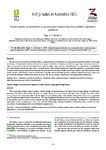Mostrar o rexistro simple do ítem
Diseño óptimo de actuadores y sensores para sistemas lineales mediante algoritmos genéticos
| dc.contributor.author | Tapia Córdoba, Alejandro | |
| dc.contributor.author | Orihuela, Luis | |
| dc.date.accessioned | 2023-10-09T08:12:57Z | |
| dc.date.available | 2023-10-09T08:12:57Z | |
| dc.date.issued | 2023 | |
| dc.identifier.citation | Tapia, A., Orihuela, L.. 2023. Diseño óptimo de actuadores y sensores para sistemas lineales mediante algoritmos genéticos. XLIV Jornadas de Automática, 376-381. https://doi.org/10.17979/spudc.9788497498609.376 | es_ES |
| dc.identifier.isbn | 978‐84‐9749‐860‐9 | |
| dc.identifier.uri | http://hdl.handle.net/2183/33635 | |
| dc.description.abstract | [Resumen] En este trabajo se revisita un problema clásico: el diseño óptimo de actuadores y/o sensores para sistemas lineales e invariantes en el tiempo. Considerando el sistema descrito en el espacio de estados, el objetivo sería el de escoger, bajo ciertas restricciones, la matriz de entrada B y/o la matriz de salida C para optimizar algún criterio asociado, habitualmente, con el grado de controlabilidad y/u observabilidad del sistema. Este trabajo propone resolver este problema empleando algoritmos genéticos. La principal ventaja de esta herramienta es que permite introducir las restricciones de forma muy sencilla, permitiendo resolver el problema de una forma mucho más general de las que existen en la literatura. Además, esta metodología permite considerar optimización multi-objetivo de forma directa, pudiendo analizar la situación en la que más de uno de estos criterios sean interesantes para la aplicación. | es_ES |
| dc.description.abstract | [Abstract] This manuscript revisits a classic problem: optimal design of actuators/sensors for linear time-invariant systems. Considering a state-space description of the system, the goal is to design, subject to some constraints, the input matrix B and/or the output matrix C to optimize some criteria associated with the degree of controlability and/or observability of the system. This work proposes the use of evolutionary algorithms for this problem. The first advantage is that this tool allows to introduce constraints in a simple way, so the problem can be solved in a much general way than other approaches found in the literature. Furthermore, multi-objective optimization can be considered in a direct way with this methodology, making it possible to analyze the case in which more than one criterion is insteresting for the control/estimation application. | es_ES |
| dc.description.sponsorship | Ministerio de Ciencia e Innovación; PID2020-117800GBI00 | es_ES |
| dc.description.sponsorship | Ministerio de Ciencia e Innovación; RYC2021-032919-I | es_ES |
| dc.language.iso | spa | es_ES |
| dc.publisher | Universidade da Coruña. Servizo de Publicacións | es_ES |
| dc.relation.uri | https://doi.org/10.17979/spudc.9788497498609.376 | es_ES |
| dc.rights | Attribution-NonCommercial-ShareAlike 4.0 International (CC BY-NC-SA 4.0) https://creativecommons.org/licenses/by-nc-sa/4.0/ | es_ES |
| dc.rights.uri | http://creativecommons.org/licenses/by-nc-sa/3.0/es/ | * |
| dc.subject | Sensores y actuadores | es_ES |
| dc.subject | Medición y actuación fiable | es_ES |
| dc.subject | Sistemas lineales | es_ES |
| dc.subject | Sistemas invariantes en el tiempo | es_ES |
| dc.subject | Algoritmos genéticos en control e identificación | es_ES |
| dc.subject | Sensors and actuators | es_ES |
| dc.subject | Reliable measurement and actuation | es_ES |
| dc.subject | Linear systems | es_ES |
| dc.subject | Time-invariant systems | es_ES |
| dc.subject | Evolutionary algorithms in control and identification | es_ES |
| dc.title | Diseño óptimo de actuadores y sensores para sistemas lineales mediante algoritmos genéticos | es_ES |
| dc.title.alternative | Optimal design of actuators and sensors for linear systems using genetic algorithms | es_ES |
| dc.type | info:eu-repo/semantics/conferenceObject | es_ES |
| dc.rights.access | info:eu-repo/semantics/openAccess | es_ES |
| UDC.startPage | 376 | es_ES |
| UDC.endPage | 381 | es_ES |
| dc.identifier.doi | https://doi.org/10.17979/spudc.9788497498609.376 | |
| UDC.conferenceTitle | XLIV Jornadas de Automática | es_ES |






